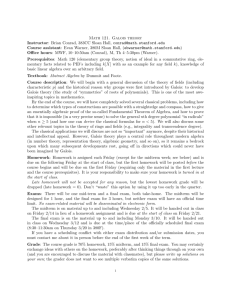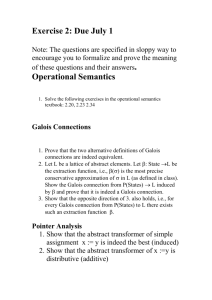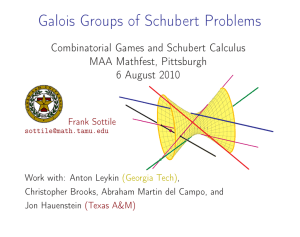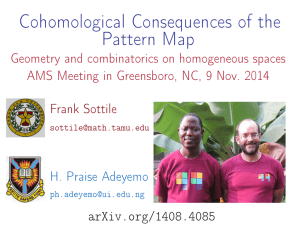Galois Groups of Schubert Problems USC Mathematics Colloquium 3 December 2014
advertisement
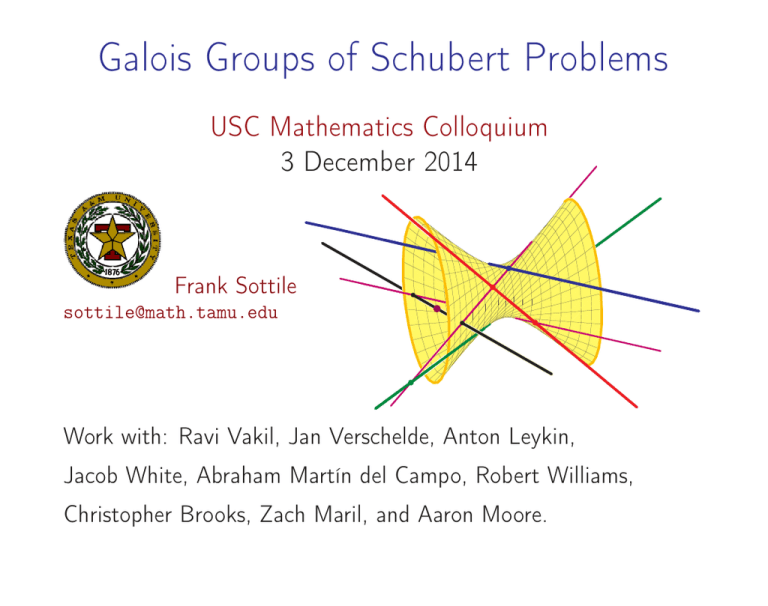
Galois Groups of Schubert Problems USC Mathematics Colloquium 3 December 2014 Frank Sottile sottile@math.tamu.edu Work with: Ravi Vakil, Jan Verschelde, Anton Leykin, Jacob White, Abraham Martín del Campo, Robert Williams, Christopher Brooks, Zach Maril, and Aaron Moore. Galois theory and the Schubert calculus Galois theory originated from understanding symmetries of roots of polynomials. Later, Galois groups came to be understood as encoding all the symmetries of field extensions. Today, it is a pillar of number theory. Galois groups also appear in enumerative geometry. This aspect is not well-developed, because of its subtlety and because Galois groups are very hard to determine. I will describe a project to shed more light on Galois groups in enumerative geometry. It is focussed on Galois groups in the Schubert calculus, a well-studied class of geometric problems involving linear subspaces. It is best to begin with examples. Frank Sottile, Texas A&M University 1 The Problem of Four Lines What are the lines mi meeting four general lines ℓ1, ℓ2, ℓ3, and ℓ4? The lines ℓ1, ℓ2, ℓ3 lie on a unique hyperboloid Q of one sheet, and the lines that meet ℓ1, ℓ2, ℓ3 form one ruling of Q. Thus the solutions mi are the lines in that ruling passing through the points of intersection ℓ4 ∩ Q. Rotating the line ℓ4 180◦ around the point p interchanges the two solution lines m1 , m2 . This shows that The Galois group of the problem of four lines is the symmetric group S2. Frank Sottile, Texas A&M University 2 The Problem of Four Lines What are the lines mi meeting four general lines ℓ1, ℓ2, ℓ3, and ℓ4? The lines ℓ1, ℓ2, ℓ3 lie on a unique hyperboloid Q of one sheet, and the lines that meet ℓ1, ℓ2, ℓ3 form one ruling of Q. Thus the solutions mi are the lines in that ruling passing through the points of intersection ℓ4 ∩ Q. ℓ3 ◦ Rotating the line ℓ4 180 around the point p interchanges the two solution lines m1 , m2 . This shows that ℓ2 Q ℓ1 The Galois group of the problem of four lines is the symmetric group S2. Frank Sottile, Texas A&M University 2 The Problem of Four Lines What are the lines mi meeting four general lines ℓ1, ℓ2, ℓ3, and ℓ4? The lines ℓ1, ℓ2, ℓ3 lie on a unique hyperboloid Q of one sheet, and the lines that meet ℓ1, ℓ2, ℓ3 form one ruling of Q. Thus the solutions mi are the lines in that ruling passing through the points of intersection ℓ4 ∩ Q. m2 ℓ3 ◦ Rotating the line ℓ4 180 around the point p interchanges the two solution lines m1 , m2 . This shows that ℓ4 ℓ2 m1 Q ℓ1 The Galois group of the problem of four lines is the symmetric group S2. Frank Sottile, Texas A&M University 2 The Problem of Four Lines What are the lines mi meeting four general lines ℓ1, ℓ2, ℓ3, and ℓ4? The lines ℓ1, ℓ2, ℓ3 lie on a unique hyperboloid Q of one sheet, and the lines that meet ℓ1, ℓ2, ℓ3 form one ruling of Q. Thus the solutions mi are the lines in that ruling passing through the points of intersection ℓ4 ∩ Q. m2 ℓ3 ◦ Rotating the line ℓ4 180 around the point p interchanges the two solution lines m1 , m2 . ℓ4 ℓ2 p This shows that ✑ ✑ ✑ ✑ ✑ ✑✸ m1 Q ℓ1 The Galois group of the problem of four lines is the symmetric group S2. Frank Sottile, Texas A&M University 2 The Problem of Four Lines What are the lines mi meeting four general lines ℓ1, ℓ2, ℓ3, and ℓ4? The lines ℓ1, ℓ2, ℓ3 lie on a unique hyperboloid Q of one sheet, and the lines that meet ℓ1, ℓ2, ℓ3 form one ruling of Q. Thus the solutions mi are the lines in that ruling passing through the points of intersection ℓ4 ∩ Q. m2 ℓ3 ◦ Rotating the line ℓ4 180 around the point p interchanges the two solution lines m1 , m2 . ℓ4 ℓ2 p This shows that ✑ ✑ ✑ ✑ ✑ ✑✸ m1 Q ℓ1 The Galois group of the problem of four lines is the symmetric group S2. Frank Sottile, Texas A&M University 2 A Problem with Exceptional Geometry Q: What 4-planes H in C8 meet four general 4-planes K1, K2, K3, K4 in a 2-dimensional subspace of each? Auxiliary problem: There are four (h1, h2, h3, h4) 2-planes in C8 meeting 4 each of K1, K2, K3, K4. Schematically, = 4. Fact: All solutions H to our problem have the form Hi,j = hhi, hj i for 1 ≤ i < j ≤ 4. Schematically, 4 = 6. 4 It follows that the Galois group of = 6 equals the Galois group 4 = 4, which is the symmetric group S4. This action is not of two-transitive. 4 This problem = 6 also has exceptional reality: If K1, K2, K3, K4 are real, then either two or six of the Hi,j are real, and never four or zero. Frank Sottile, Texas A&M University 3 Galois Groups of Enumerative Problems In 1870, Jordan explained how algebraic Galois groups arise naturally from problems in enumerative geometry; earlier (1851), Hermite showed that such an algebraic Galois group coincides with a geometric monodromy group. This Galois group of a geometric problem is a subtle invariant. When it is deficient (i.e. not the full symmetric group), the geometric problem has some exceptional, intrinsic structure. Hermite’s observation, work of Vakil, and some number theory together with modern computational tools give several methods to determine Galois groups, at least experimentally. I will describe a project to study Galois groups for problems coming from the Schubert calculus using numerical algebraic geometry, symbolic computation, combinatorics, and more traditional methods. Frank Sottile, Texas A&M University 4 Some Theory π A degree e surjective map E − → B of equidimensional irreducible varieties (up to codimension one, E → B is a covering space of degree e) Ã degree e extension of fields of rational functions π ∗K(B) ⊂ K(E). Define the Galois group Gal(E/B) ⊂ Se to be the Galois group of the Galois closure of this extension. Hermite’s Theorem. (Work over C.) Restricting E → B to open subsets over which π is a covering space, E ′ → B ′, the Galois group is equal to the monodromy group of deck transformations. This is the group of permutations of a fixed fiber induced by analytically continuing the fiber over loops in the base. Point de départ: Such monodromy permutations are readily and reliably computed using methods of numerical algebraic geometry. Frank Sottile, Texas A&M University 5 Enumerative Geometry “Enumerative Geometry is the art of determining the number e of geometric figures x having specified positions with respect to other, fixed figures b.” — Hermann Cäser Hannibal Schubert, 1879. B := configuration space of the fixed figures, and X := the space of the figures x we count. Then E ⊂ X × B consists of pairs (x, b) where x ∈ X has given position with respect to b ∈ B . The projection E → B is a degree e cover outside of some discriminant locus, and the Galois group of the enumerative problem is Gal(E/B). In the problem of four lines, B = four-tuples of lines, X = lines, and E consists of 5-tuples (m, ℓ1, ℓ2, ℓ3, ℓ4) with m meeting each ℓi. We showed that this has Galois group the symmetric group S2. Frank Sottile, Texas A&M University 6 Schubert Problems The Schubert calculus is an algorithmic method promulgated by Schubert to solve a wide class of problems in enumerative geometry. Schubert problems are problems from enumerative geometry involving linear subspaces of a vector space incident upon other linear spaces, such as the problem of four lines, and the problems 4 4 = 6. = 4 and m2 ℓ3 ℓ4 ℓ2 m1 Q ℓ1 As there are many millions of computable Schubert problems, many with their own unique geometry, they provide a rich and convenient laboratory for studying Galois groups of geometric problems. Frank Sottile, Texas A&M University 7 Proof-of-concept computation Leykin and I used off-the-shelf numerical homotopy continuation software to compute Galois groups of some Schubert problems formulated as the intersection of a skew Schubert variety with Schubert hypersurfaces. In every case, we found monodromy permutations generating the full symmetric group (determined by Gap). This included one Schubert problem with e = 17, 589 solutions. We conjectured that problems of this type will always have the full symmetric group as Galois group. As a first step, White and I showed these Galois groups are 2-transitive as permutation groups. The bottleneck to studying more general problems numerically is that we need numerical methods to solve one instance of the problem. Frank Sottile, Texas A&M University 8 Numerical Project Recent work, including certified continuation (Beltrán and Leykin), Littlewood-Richardson homotopies (Vakil, Verschelde, and S.), regeneration (Hauenstein), implementation of Pieri and of Littlewood-Richardson homotopies (Martín del Campo and Leykin) and new algorithms in the works will enable the reliable numerical computation of Galois groups of more general problems. We plan to use a supercomputer whose day job is calculus instruction to investigate many of the millions of accessible and computable Schubert problems. Our intention is to build a library of Schubert problems (expected to be very few) whose Galois groups are deficient. These data would be used to generate conjectures, leading to proofs about Galois groups of Schubert problems, as well as showcase the possibilities of numerical computation. Frank Sottile, Texas A&M University 9 Vakil’s Criteria Vakil introduced two combinatorial criteria which can be used to show that the Galois group of a Schubert problem contains the alternating group. (Is at least alternating). The first criterion is simple combinatorics, while the second requires knowledge of 2-transitivity. Theorem. (Brooks, Martín del Campo, S.) The Galois group of any Schubert problem involving 2-planes in Cn is at least alternating. By Vakil’s second criterion, to show high-transitivity (Se or Ae), we often only need 2-transitivity. All known Galois groups of Schubert problems are either at least alternating or fail to be 2-transitive. White and I are studying 2-transitivity. Theorem. Every Schubert problem involving 3-planes in Cn is 2-transitive. Every special Schubert problem (partition a single row) is 2-transitive. Ã The proof suggests that not 2-transitive implies imprimitive. Frank Sottile, Texas A&M University 10 Vakil’s Criteria II Vakil’s geometric Littlewood-Richardson rule, his criteria, and some 2-transitivity give an algorithm that can show a Schubert problem has at least alternating monodromy. Python code written by Brooks is being modified by Maril and Moore to implement this algorithm. There are serious computer-science challenges to overcome. Our goal is to use it to test all Schubert problems on all small Grassmannians (many hundreds of million Schubert problems), and get a second library of Schubert problems with deficient Galois groups. Frank Sottile, Texas A&M University 11 Specialization Lemma Given π : E → B with B rational, the fiber π −1(b) above a Qrational point b ∈ B(Q) has a minimal polynomial py (t) ∈ Q[t]. In this situation, the algebraic Galois group of py (t) is a subgroup of Gal(E/B). Working modulo a prime, the minimal polynomial of such fibers are easy to compute when e . 500. The degrees of its irreducible factors give the cycle type of a Frobenius element in the Galois group. This quickly determines the Galois group when it is the full symmetric group, and allows the estimation of the Galois group when it is not. Using Vakil’s criteria and this method, we have determined the Galois groups of all Schubert problems involving 4-planes in C8 and C9. (The first interesting case.) The deficient Schubert problems fall into a few easilyidentified families, which suggests the possibility of classifying all deficient Schubert problems and identifying their Galois groups. Frank Sottile, Texas A&M University 12 Thank You! m2 ℓ3 ℓ4 ℓ2 p✑ ✑ ✑ ✑ ✸ ✑ ✑ m1 Q Frank Sottile, Texas A&M University ℓ1 A Problem with Exceptional Geometry Q: What 4-planes H in C8 meet four general 4-planes K1, K2, K3, K4 in a 2-dimensional subspace of each? Auxiliary problem: There are four (h1, h2, h3, h4) 2-planes in C8 meeting 4 each of K1, K2, K3, K4. Schematically, = 4. Fact: All solutions H to our problem have the form Hi,j = hhi, hj i for 1 ≤ i < j ≤ 4. Schematically, 4 = 6. 4 It follows that the Galois group of = 6 equals Galois group of 4 = 4, which is the symmetric group S4. This action is imprimitive. 4 = 6 also has exceptional reality: If K1, K2, K3, K4 This problem are real, then either two or six of the Hi,j are real, and never four or zero. Frank Sottile, Texas A&M University 1


